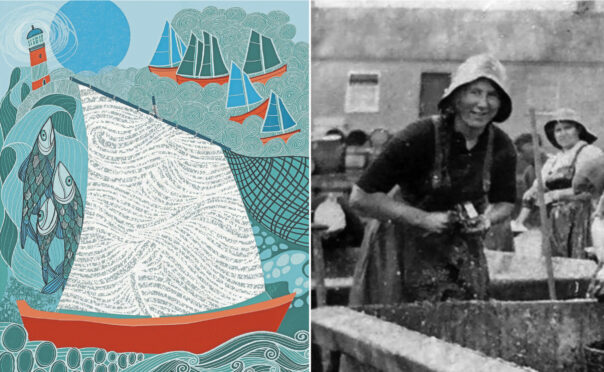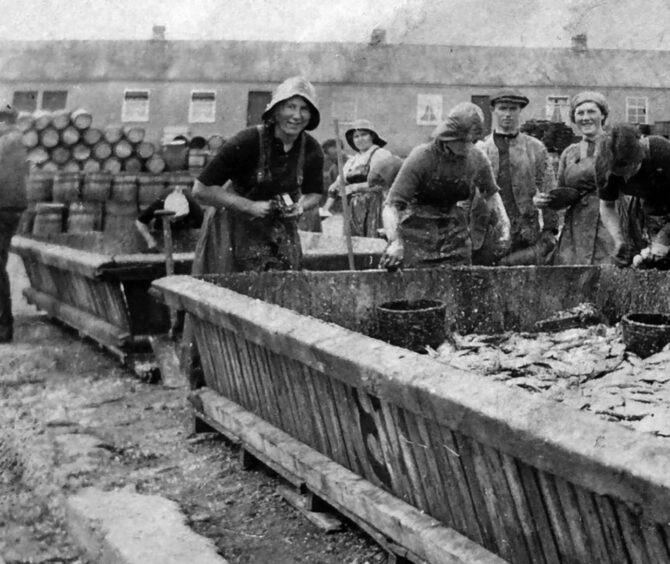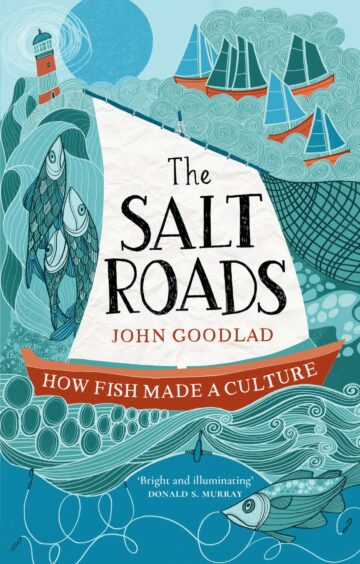
We all know about French and Italian cuisine but there was a time when Europe’s finest restaurants and dining rooms were thrilled by salt fish from Shetland.
Today it’s still eaten with relish in Spain and Portugal but salt cod is rarely seen anywhere else, and Shetlanders no longer produce the salt fish that powered an economic boom in these northerly islands and made them the centre of the world’s salt fish industry.
In The Salt Roads, John Goodlad tells the story of how salt fish from Shetland became one of the staple foods of Europe with fishing boats braving the wild and perilous waters of the North Atlantic, the ice-filled fjords of Greenland and the remote islands of Faroe to catch and cure salt cod destined for the bacalao restaurants of Spain and herring for the Jewish shtetls of Eastern Europe.
“As we have become accustomed to our modern world of supermarket shopping, with its ‘just in time’ supply lines, it is difficult to appreciate just how important salt fish once was in shaping the economies, societies and cultures of much of Europe,” said Goodlad, a Shetlander who works in the seafood industry and is a former CEO of the Shetland Fishermen’s Association.
“Salt herring and salt cod was regularly eaten by millions of people and huge industries were based on catching, curing and selling it. The enormous demand for salt fish brought employment and prosperity to hundreds of small fishing communities. In Shetland salt fish came to dominate life in, and shape the culture of, the islands for hundreds of years.”
It was salt cod that first brought prosperity to the islands, where most people had previously scraped a serf-like subsistence from crofting and fishing in open boats for ling and tusk, with any profit being swallowed by landlords. In 1818, when Shetlanders discovered a rich fishing ground known as the Papa Bank south-west of Foula, which became known as the Home Grounds, cod fishing began, ushering in an era of prosperity and social change.
At the time, salt cod trade was dominated by the Basques who had been fishing in their secret fishing grounds off Newfoundland since the 16th Century but it wasn’t until curing methods were perfected in the middle of the 19th Century and fishing boats ventured further afield to fishing grounds around Greenland and Faroe that the Shetland bonanza took off.
Cod, back-breakingly hauled up on lines by hand, were bled, split and salted onboard. After months at sea, the fish were laid out to dry on the islands’ many windswept, stone beaches. Thanks to islanders’ expertise, Shetland salt cod soon became the most prized in the world and fortunes were made during the golden years of cod fishing.
“Eventually carving out its own distinctive market niche, the ‘Shetland cure’ became synonymous with some of the best quality salt cod available, for which Spanish buyers were prepared to pay top prices,” said Goodlad. “Shetland became the hub of a large, distant-water cod fishery that was international in its reach, extending from the Arctic waters off north-east Iceland to the warm waters of Spain, where most of the cod was sold.”
Cod fishing in Shetland went into decline when herring fishing took off in the 1880s. Skippers and crews deciding herring fishing was easier and more economically efficient as it was carried out nearer to home shores using fine drift nets rather than lines.
“Shetland did not gradually develop its herring fishery. Herring exploded on to the scene – the fisheries equivalent of the big bang,” said Goodlad. “From nothing to a fleet of more than 300 herring boats in less than 10 years, it was as if the Californian gold rush had arrived in Shetland. Exports of salt cod to Spain dwindled, replaced by exports of salt herring to eastern Europe that increased year after year.
“Before too long, fishermen began to see that they could own the boats themselves, no longer needing merchants or curers as part-owners.
“It was not, however, only better pay, and the prospect of becoming shareholders, that persuaded men to leave the cod. It was also an easier job. The daily routine of fishing during the night and landing the catch of herring every morning allowed fishermen to be ashore for a few hours every day. This was a world of difference from a long, 12-week distant-water trip to Faroe and Iceland.”
At the height of the herring boom, in 1905, more than 113,000 tons were landed in Shetland by more than 400 boats employing around 3,000 fishermen. More than one million barrels were exported, and Shetland became known as the herring capital of Europe. “The herring boom allowed Shetland fishermen to earn wages that, a few years previously, would have been regarded as unbelievable,” added Goodlad. “It also provided paid employment for women, who had been excluded from cod fisheries.” Wages were poor, the hours long and the work gruelling but working as a gutter allowed young women to escape the drudgery of the family croft and staying in gutters’ huts for a few months every year gave them a taste of independence.
“The opportunities afforded by gutting herring were nothing short of a social revolution in Shetland society,” said Goodlad.
The boom ended with the First World War. When war was declared on Germany, Britain lost one of its main export markets for salt herring overnight. Unrest in Russia followed by the revolution devastated another huge market. Between the wars, the German fishing fleet expanded to reduce reliance on imported herring and the trade with the Soviet Union was not as straightforward as it had been with Tsarist Russia.
“Most problematic was the decline in the mass market for salt herring. As living standards began to edge upwards throughout Europe, salt herring was no longer the only affordable source of protein for most people,” added Goodlad.
The Second World War further disrupted the herring trade when Jewish trading companies in Germany who bought thousands of barrels of salt herring from Shetland were wiped out following the Nazi Holocaust. By the 1950s, the mass market had largely gone. But Goodlad said: “These great fisheries, which moulded the economy and society of Shetland for hundreds of years, have not entirely disappeared. Much of Shetland’s oral history and folklore is still bound up with stories of the sea and all those who worked the fishing industry.
“The main legacy of this heritage is the contemporary seafood industry. There are few fishers and fish farmers in Shetland today whose ancestors were not fishermen, beach boys, coopers or gutters.”
The salt fish years may be a memory but fish continue to underpin the islands’ considerable prosperity, contributing a third to the Shetland’s economic output. Today, Shetland’s fishing industry and aquaculture (fish and shellfish farming) is worth £320 million a year to the economy, and more than a quarter of the UK’s fish is landed in Shetland – more than England, Wales and Northern Ireland combined. Four in five mussels farmed in Scotland are from Shetland and a quarter of farmed salmon.
“This is not a book about looking at the past and lamenting a great industry that’s gone,” said Goodlad. “The seafood industry remains of huge importance to Shetland but what I’m describing paved the way for social change and laid the foundation for what we have now, which is a fleet owned by the fishermen themselves.”
From the book
I was lucky to have experienced the last years of the drift net era. My childhood was immersed in the routine of the herring fishing. The setting was the village of Hamnavoe, on the island of Burra. Located in a perfect, natural harbour, it is defined by a single pier, around which most of the houses are clustered in a large semi-circle. When I was growing up, there were around a dozen drift net boats from the village, each with its own evocative name. Replenish, Venture, Radiant Star and Golden Harvest are some of the names that still trip off my tongue effortlessly.
I marvel at what I can remember. I can pretty much recall who the crew were on board each boat, what its registration number was, the colour of its wheelhouse and so on. I was not unusual; all the children knew as much as I did. When the fleet was tied up at the pier for the weekend, this was our playground: we’d scramble from boat to boat, fishing off the sterns with home- made lines. The life of the village revolved around the herring season. There was hardly anyone at school whose father was not a fisherman, and most of our mothers had been gutters when they were younger.
I recall pestering my mother to allow me to stay up late so I could hear the drift net skippers speaking on the radio as they searched for herring. Every house had a large wireless, the main purpose of which was to listen to the fishing news on a designated fishing boat channel known as the trawler band. The Home Service or the Light Programme (the forerunners of Radio 4 and Radio 2) were only tuned into when it was known that no one from the boats would be speaking.
Once the nets had been shot, some of the watchmen would sing hymns over the radio. I can recall fighting the sleep that was overpowering me, hearing these men taking turns to sing their favourite hymns. There was no music, just one man singing, making the moment even more special in my memory. Two popular choices were Will Your Anchor Hold and The Old Rugged Cross, hymns that are still sung at fishermen’s funerals today.
The Salt Roads by John Goodlad, published by Birlinn, is out now

Enjoy the convenience of having The Sunday Post delivered as a digital ePaper straight to your smartphone, tablet or computer.
Subscribe for only £5.49 a month and enjoy all the benefits of the printed paper as a digital replica.
Subscribe

